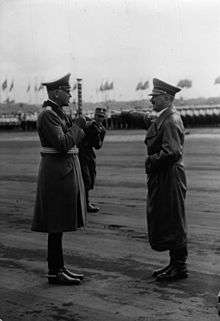Festliches Nürnberg
| Festliches Nürnberg | |
|---|---|
| Directed by | Hans Weidemann |
| Starring |
Adolf Hitler Hermann Göring Other Nazi Leaders |
| Distributed by | Reichsparteitagsfilm |
Release dates | 1937 (Berlin) |
Running time | 21 minutes |
| Country | Nazi Germany |
| Language | German |
Festliches Nürnberg (English: Festive Nuremberg) is a short 1937 propaganda film chronicling the Nazi Party rallies in Nuremberg, Germany in 1936 and 1937. The film was directed by Hans Weidemann.[1]
Synopsis



The film runs in colour for only 21 minutes (although the downloadable version at the Internet archive is monochrome only and has no English translation of the little commentary that exists), containing footage of the 8th and 9th Nuremberg Rallies. Particularly notable scenes of both the rally and the film are images of Albert Speer's lighting techniques during the 9th Nuremberg rally on 10 September 1937, in which he positioned 134 searchlights circling the Zeppelin field on which the rally was taking place. The beams of these spotlights, forming the "cathedral of light", merged into the general glow at an estimated height of 20,000 feet, and would be used for more practical purposes after war was declared in 1939.
The film is relatively short at only about 21 minutes compared with the longer Triumph des Willens and Der Sieg des Glaubens made by Leni Riefenstahl in 1934 and 1933 respectively. It adopts the same heavy style of adoration of Hitler with many scenes of marching SS men and Wehrmacht soldiers as well as navy personnel and flying aircraft overhead. With some prescience, scenes of soldiers parading in tanks and other vehicles (with guns firing) assume great prominence. The film concludes with sequences of folk dances and gymnastic displays, followed by a torchlight parade and a brief speech from Hitler.
Background
Since the formation of the Nazi Party in 1923, annual rallies had taken place at Nuremberg, mainly orchestrated by the 'minister for public enlightenment' Joseph Goebbels. The Nazi party, as it was known, also called upon architect Albert Speer to create a number of spectacles to inspire the German population. The 8th and 9th of these rallies were known as the "Rally of Honor" (Reichsparteitag der Ehre) and the "Rally of Labor" (Reichsparteitag der Arbeit) respectively for 1937 and 1938. The rally for 1939 would be ironically known as the "Rally for Peace" but was postponed indefinitely as war approached in September 1939.
The film followed the much longer Riefenstahl films of 1933 and 1934 and the reason for the smaller movie is not known. Indeed, many of the film sequences follow Riefenstahl quite closely, such as the introduction using aerial shots of the city of Nuremberg. The score uses Richard Wagner's Die Meistersinger von Nürnberg for musical accompaniment. As for it being much shorter, perhaps the propaganda objectives of the earlier films had been met by 1937/8, and Nazi attention was then turning to militaristic adventures, which culminated in the Second World War when Hitler invaded Poland. It followed the Anschluss of 1937 when Austria was subverted and then invaded by Germany, and the Munich crisis of 1938, when a large part of Czechoslovakia, the Sudetenland, was absorbed by the Third Reich.
See also
References
- ↑ Zimmermann, Peter (2005). Hoffmann, Kay, ed. "Propagandafilme der NSDAP". Geschichte des dokumentarischen Films in Deutschland. Band 3 'Drittes Reich' 1933-1945 (in German). Reclam. Retrieved 2007-10-31.
External links
- Festliches Nürnberg at the Internet Movie Database
- The short film Festliches Nürnberg is available for free download at the Internet Archive
- Historylearningsite.co.uk
- Museen.nuernberg.de